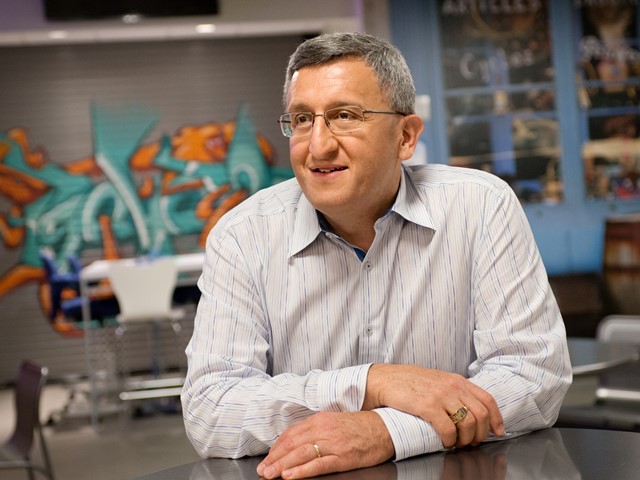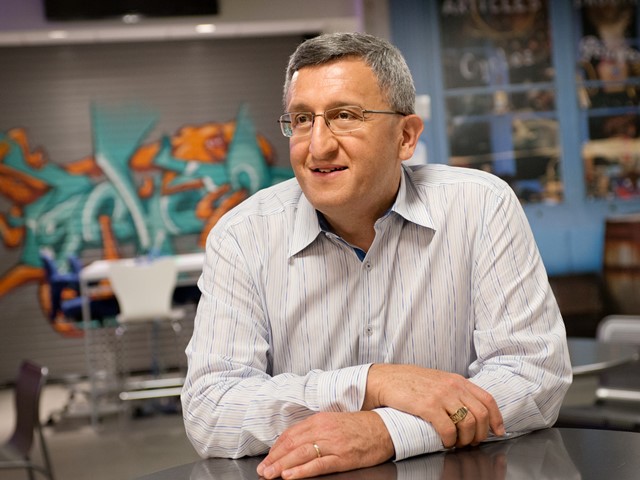Draper, the MIT spin-off engineering lab, is famed for developing the Apollo 11 Guidance Computer (not Draper Esprit, I hasten to add). Ken Gabriel, President and CEO, also recently made a major announcement. Blue Origin has now partnered with Lockheed Martin and Northrop Grumman to build elements of the company’s human-rated lunar lander, and Draper will lead the development of the lander’s avionics and guidance systems, with an aim to be ready to land a crew on the moon by 2024.
“While Blue Origin is the prime contractor, Lockheed Martin is building the ascent stage, Northrop Grumman is building the transfer element and Draper is doing the GNC (guidance, navigation and control),” Blue Origin CEO and founder Jeff Bezos said, announcing the move at the International Astronautical Congress in Washington. Blue Origin is competing for a NASA contract to develop a crewed lunar lander, or Human Landing System, for the Artemis program, which aims to return astronauts to the surface of the moon by the end of 2024.
TechCrunch sat down to chat with Gabriel, who previously he co-founded Google’s Advanced Technology and Projects (ATAP) group, to tlak about what he sees coming up in the future for the most advanced technologies. Prior to this, he was Deputy and Acting Director of the famed DARPA in the U.S. Department of Defense. During his tenure, DARPA advanced capabilities in hypersonics, offensive and defensive cyber, and big data analytics for intelligence and national security.
Ken is regarded as the ‘godfather’ of MEMs – miniaturized and integrated mechanical and electrical technology, which helps phones orient themselves, car airbags to know when to fire, biomedical devices save lives and create entirely new capabilities with smaller size, weight and power.

In September, Draper said it had set a new performance standard for being able to see more objects in all weather conditions using its LiDAR technology. LiDAR detectors tend to ‘go blind’ when they encounter too much light or too many obscurants, like rain, snow and fog. Draper’s Hemera LiDAR Detector has managed to solve that problem by incorporating technology normally used in biomedicine to see through fluids in the body.
The result is that the system is able to collect tens of billions of photons per second, far more than most LiDAR systems, which can detect only millions of photons per second.
Here he makes some predictions for the future:
Ken Gabriel (KG): Draper is famed for creating capabilities that have never existed before. It goes back to the inertial guidance system days we did for the Apollo Guidance computer. We broke off from M.I.T about 45 years ago to become an independent mont-for-profit company that operates like a for-profit in that we plough the money back into new technologies. That gives us the freedom to do big, bold things that really make a difference and create new capabilities. We have people across working in different areas.
We had someone working in the biomedical imaging world who said “Wait a minute. The biomedical imaging world has all these algorithms with techniques to see through murky fluids. So we adapted that for our Lidar technology to see through fog.
It’s that kind of capability we can develop. Draper has been on every NASA human mission to the moon, not many companies can claim that.
Mike Butcher (MB): There’s a lot more investment going into SpaceTech now there are plans to return to the moon. What do you think are the key things that people should look out for in this sector over the next few years?
KG: I would say I think it falls into roughly three categories. Interestingly enough I think space tourism is going to drive a big part of this. Plenty of people can afford it and it will drive many commercial space companies going forward. It will eventually cost about $50,000 to go into space, putting it within reach of a lot of people, globally.
Another driver is the information that you can extract from space about Earth. Examples are being able to see the star of the coral reefs or track wildlife in Africa using imagery data algorithms.
The third is related to space and economy. There are certain rare earth metals and gases which are rare on the Earth, but plentiful on the moon, such as Helium 3. Then there is fusion technologies you potentially do in space.
There’s a lot of potential for in-space manufacturing that’s expensive or tricky to do on the Earth that will be less tricky and expensive to do in space.
For instance, if you need a lot of energy to do something, it’s likely going to be more gonna be cost-effective in space. And if you’re on the moon already turning ice into water and getting hydrogen and oxygen then you’ve also got the fuels and the energy that you need to do that right there.
It’s also about 30 times more efficient to go to Mars from the moon, than form the Earth from an energy perspective. The pull of gravity is six times less than the pull of gravity on the earth. So the intended missions to Mars will actually be one of the things that will drive us going back to the Moon.
Autonomous systems will also be improved by the space race, because in order to get missions to the lunar surface, to deliver supplies, then you will need better and better autonomous capabilities which will then flow back to autonomous vehicles, trucks, drones everything.
MB: What are the kinds of fundamental technologies and things coming up that you think investors should take a look at?
KG: Well, so we’ve touched on automation and some of the autonomous lighter stuff. I think the other big area for investors is the intersection of engineering and biotech, biopharma and medicine. I’ll give you two specific examples. One, in the area of drug development. So… 50 years ago, for a billion dollars you could develop 30 drugs, in the 1980s. A billion dollars got through three drugs. Today a billion dollars gets you 0.3 drugs. In other words, you need at least three billion dollars to get one drug. It’s the opposite of Moore’s Law. Why? Because drug development has fundamentally not changed in 50 years, and it has become more risk-averse. Only 20 percent of drugs that started out in development make it to being released to humans. The reason for that is the screening of candidate drugs is done on animals and they don’t predict well. So you develop this drug. It passes animal testing, and then it starts to go into the human clinical trials. And it fails. Four or five months ago Biogen had an Alzheimer’s drug fail. They lost 36 percent of their market cap, not mentioning the $7 billion dollars they had spent on developing it.
From our perspective, one solution is to re-create human organ systems that mimic the way different organs react using chambers, heaters, pumps and make them communicate as they would in your body. Then I can see what the effect on the heart is if I’m developing something for a kidney.
MB: Do you mean do you think that the private sector is outperforming the public sector in this kind of research?
KG: The difference between the first time and the second time I was at DARPA (roughly the 1990s early 90s versus 2009) Was that in the 90s you could still leapfrog commercial technologies. That is increasingly hard to do because they is just so much private sector activity. But in certain targeted areas, I still think DARPA can do disruptive innovation. But one of the things that I have practiced and I’m practicing at Draper is what I call ‘disciplined innovation’. Which is a little contrary to what most people think of it as being.
For example, most people will tell you the best way to get breakthrough innovations a lot of money and time to smart people. Sometimes that works, but it’s not particularly efficient. You lose urgency. And you lose focus.
President Kennedy’s Moonshot was a perfect example of discipline innovation: Bold goal, fixed duration and timeframe, and independence. This is where it becomes really important. Because unless you have independence for these projects, these bold projects, at the highest level, they will die. Because the existing businesses, business units, will see that disruptive innovation as a threat and kill it off. The biggest enemies of disruptive innovation are internal enemies. So that’s why I don’t believe in “chief innovation officers”. The CEO should be the chief innovation officer. Not that I expect the CEO to be in the lab doing the work. But the CEO is the only one who has the entire company’s viewpoint in mind and is responsible for it
MB: What are the technologies you see come across your desk at the moment. What are the ones that you would like to see happen?
KG: Robots are leaving the factory floor We’re getting more and more autonomy around us whether it’s autonomous vehicles or drones. You’re going to find more autonomous robots delivering things and taking care of humans.
The other major area is the intersection of engineering, biotech and biopharma. Because of two reasons. One: principally the demand for health care. And biology is becoming more quantitative. Once you understand mechanisms then engineering can help solve something. A good example of that it took a decade and a billion dollars to sequence the genome. Now it’s a hundred bucks and you get it back in a week.
MB: What about climate tech?
KG: There are lots of existing technologies as well as the potential for new ones to help the climate. I’m not a big fan of saying carbon dioxide is in the air so we have to stop using fuels. Why can’t I draw it out? There are ways of sucking carbon sequestration where we don’t have to plant 10 million trees, and it will take too long. But we can make systems. Couple that with the earlier discussion we were having about space. Better monitoring from space. Tracking plastics tracking animals. tracking oil spills. All of that is going to be a solution.































Comment